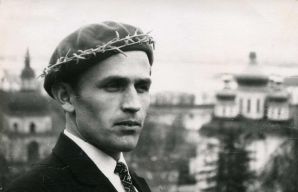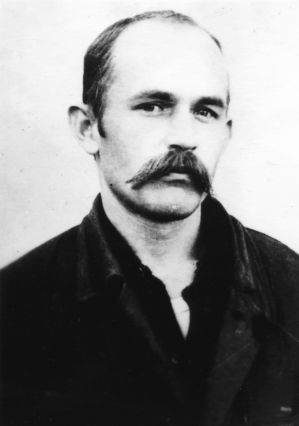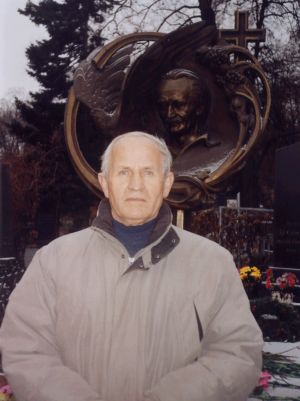HEVRYCH, YAROSLAV BOHDANOVYCH (born November 28, 1937, in the village of Ostapie, now Pidvolochyskyi district, Ternopil oblast). Dentist, participant in the Sixtiers movement, public figure.
Born into the family of a Greek Catholic priest. His father was imprisoned for refusing to convert to Moscow Orthodoxy. His mother, Yelyzaveta Rachkovska, had a university education, was fluent in six languages, and was a specialist in Greek and Latin, but she was forbidden to work as a teacher. Nevertheless, all five children—three sisters and two brothers—achieved higher education through their own efforts.
After graduating from secondary school in 1954, Yaroslav entered a two-year technical school in Stanislaviv, where he trained as a mechanic for the repair and operation of construction machinery. He worked in the garage of the Kosiv forestry enterprise. From 1957 to 1960, he completed his three-year military service. In 1960, he entered the dental faculty of the O. Bohomolets Kyiv Medical Institute. He was a co-organizer of the institute’s banduryst kapelle.
He lived in the same dormitory as M. PLAKHOTNIUK, and together they attended rehearsals of the “Zhaivoronok” choir, visited the Ivan Honchar Museum, participated in the work of the Club of Creative Youth, and organized caroling groups. On May 16, 1964, they took part in a memorable trip for medical students by boat to Kaniv to visit Taras Shevchenko’s grave. During the summer vacation of 1964, Hevrych traveled through the Carpathians with a group of young people from Kyiv and Lviv.
In the village of Sheshory, Kosiv district, he met the head of the village council, Volodymyr Mykhailiuk, who showed him fragments of a monument to T. Shevchenko that had been destroyed by Hungarian troops during the war. Hevrych told the sculptor and ethnographer Ivan Honchar and the architect Hryhoriy Kovbasa about this in Kyiv. They created a new monument for free; the villagers collected money for the materials and casting, and installed it on a pedestal on a high mound, as it had been before. The head of the council envisioned the unveiling as a “celebration for all the mountains.” But on the eve of the event, he was detained by the KGB. Dozens of buses were turned back by the police at the turnoff to Sheshory, and scheduled bus services were canceled. Hevrych and a group of people walked to Sheshory. The stage by the monument was decorated with Hutsul carpets and embroidery, but there was no one to officially unveil the monument; only Tetiana Tsymbal recited Shevchenko’s poems, and V. CHORNOVIL gave a brief speech.
Radio Liberty reported on the event that same evening, so the authorities decided to hold an official unveiling on August 21, 1965—with “amateur performances,” flags, portraits of Lenin, and reports on “labor achievements.” Hevrych was present at this unveiling as well. On August 28, 1965, Hevrych was traveling to Kyiv for his studies. In the town of Tysmenytsia, a KGB captain named Hryhoriev removed him from the bus and took him to the Ivano-Frankivsk pre-trial detention center. They confiscated photocopies of foreign editions of the booklets “Ukraine and the Ukrainian Policy of Moscow” and “A Deduction of the Rights of Ukraine,” a feuilleton about Khrushchev, and two rolls of film.
The next day, he was transported under escort by plane to Kyiv, to the KGB pre-trial detention center of the Ukrainian SSR, and charged with conducting anti-Soviet agitation and propaganda under Article 62, Part 1 of the Criminal Code of the Ukrainian SSR. For seven months, Hevrych was held in a solitary confinement cell and subjected to a brief psychiatric examination, which found him sane. The case was handled by investigator Koval. He tried to link Hevrych’s case with that of O. Martynenko, I. RUSYN, and Ye. KUZNETSOVA, but Hevrych did not even know these people. For a time, his accomplice was considered to be the disabled artist Petro Morhun (who had only one arm), with whom Hevrych had made photocopies of samvydav from film he had borrowed from Ye. PRONIUK. Morhun was released even before the trial, which opened on Taras Shevchenko’s birthday, March 9, 1966. At a confrontation on December 10, 1965, A. HORSKA denied giving Hevrych a photocopy of the book “Ukraine and the Ukrainian Policy of Moscow.” “In 105 days, they teach you how to lie,” Hevrych replied. The investigator did not record these words in the protocol, a fact that HORSKA reported to the Prosecutor of the Ukrainian SSR.
No facts of “distribution of anti-Soviet literature” were established: he had read something to a girl, Lesia Sandurska, and promised to give something to her brother. During the investigation, M. PLAKHOTNIUK brought parcels for Hevrych, hired a lawyer, and insisted on testifying in court. Neither the court nor the lawyer informed the family about the start of the trial. However, many friends came, summoned by M. PLAKHOTNIUK and V. CHORNOVIL. None of them were allowed into the courtroom. They managed to intercept Judge Matsko in the corridor and question him about the law under which Hevrych was being tried in a closed session. Then the police and men in plain clothes pushed them out of the corridor. Witness PLAKHOTNIUK, seeing only the judge, assessors, prosecutor, lawyer, defendant, and guards in the courtroom, refused to give testimony to this closed court, expressed outrage at the lawyer’s behavior, and addressed the defendant with words of support.
This bold defense was later incriminated against him as a crime. Even the chief of the convoy said to the judge during a break: “What are you trying him for? He is not guilty of anything.” On the second day, Hevrych was guarded by soldiers from Central Asia who did not understand Ukrainian. The judge scheduled the verdict for 2 p.m. on March 11, 1966, but announced it at 11 a.m. Before the verdict was read, a group of unknown people was brought into the hall, and only a few of Hevrych’s friends managed to get in. The sentence was 5 years in a strict-regime labor camp.
The lawyer appealed the verdict, and the cassation court reduced the term to 3 years. Hevrych’s case, like other cases from the 1965 “sweep,” gained widespread publicity thanks to the foreign publication of V. CHORNOVIL’s book “The Misfortune of Being Intelligent (Portraits of Twenty ‘Criminals’).” In transit, Hevrych met V. PIDHORODETSKY and other insurgents who were returning from the trial of Anton Oliynyk and Roman Semeniuk for escaping from a camp. Hevrych served his sentence in camp ZhKh-385/11 in the village of Potma, Mordovia. He worked at a woodworking enterprise. He was in close contact with Yu. SHUKHEVYCH, M. SOROKA, Hryts Pryshliak, and S. SOROKA. He принципиально refused to attend political education sessions, for which he was punished. A few times he was assigned to work as a dentist in the camp’s medical unit, and later in the hospital of camp ZhKh-385/3-3 in the village of Barashevo, officially registered as an orderly. At first, Hevrych refused, but friends advised him to accept the offer to have a means of maintaining contact between the Mordovian zones through the hospital. But when the camp commander saw Hevrych talking in his office with Volodymyr Horbovyi—S. Bandera’s defender at the 1936 trial—he was sent to zone ZhKh-385/17-A in the village of Ozernyi. Here he communicated with V. MOROZ and Y. Daniel. Upon his release on August 28, 1968, he smuggled out bookplates made by P. ZALYVAKHA. In Moscow, Hevrych and his father visited the apartment of Y. Daniel’s wife, Larisa BOGORAZ, who had just been arrested for participating in the “demonstration of the seven” on Red Square.
In Kyiv, after evading surveillance, he met with I. SVITLYCHNY. Hevrych was not granted a residence permit in either Galicia or Kyiv. Then, Muscovites Lyudmila ALEKSEYEVA and Veniamin Grinberg helped him register in the city of Roslavl, near Smolensk. The Kyiv Medical Institute would not reinstate him. The rector, Prof. Milko, advised him to transfer to another institute. Through the efforts of L. ALEKSEYEVA, he managed to be reinstated at the Smolensk Medical Institute. Hevrych married Oleksandra Sandurska in the town of Turka, Lviv oblast, and he himself went to Smolensk to finish his medical education. In 1970, he received his diploma and was assigned to the Penza oblast.
To avoid criminal liability, Hevrych did not collect the “relocation allowance” and went on his own to Turka. A non-Party chief physician, Stanislav Horlenko, hired him as a dentist in the village of Limna, but as a convicted person, he was not registered there because it was a border zone. Horlenko then transferred him to the village of Yasenytsia, and a year later appointed him the district dentist of the Turka Central District Hospital. He was registered in Turka only after two years. He worked there for 30 years. With the onset of “perestroika,” Hevrych organized a competition of Vertep (nativity plays) for the entire district on January 25, 1989. Twenty-five groups participated. He founded the Ukrainian Language Society, which he also headed.
He was deputy head of the district organizations of the People’s Movement of Ukraine (Rukh) and “Memorial.” Through the efforts of these organizations, a monument to T. Shevchenko was opened in Turka. In 1990, Hevrych was elected a deputy of the regional and district councils. In 1994, he headed the district organization of the Congress of Ukrainian Nationalists (KUN) and participated in the cultural events of the “Boykivshchyna” Society as a member of its board.
He was awarded the “10 Years of Ukraine’s Independence” medal, and at the Third Boyko Festival, he received a certificate and the “Honorary Boyko” medal.
His wife, O. Sandurska, works as a neurologist in Lviv. Their daughter, Olha (married name Kachai), also a doctor, has emigrated to the USA.
After retiring in 2000, Hevrych went to live with his daughter to care for his grandchildren. There he published materials about Boykivshchyna and worked in the “Boykivshchyna” Society of America and Canada. On September 16, 2006, he was elected head of the Main Board of the Society. He temporarily resides in the USA, in the state of New Jersey. He intends to return to Ukraine.
Bibliography:
1. *Tovarystvo “Boikivshchyna” v Amerytsi* [“Boykivshchyna” Society in America] // *Ameryka*, December 9, 2006. *Mii zhyttiepys* [My Autobiography] // *Litopys Boikivshchyny*, part 2, 2007.
2. Chornovil, Viacheslav. *Lykho z rozumu (Portrety dvadtsiaty “zlochyntsiv”)* [The Misfortune of Being Intelligent (Portraits of Twenty “Criminals”)]. – Lviv: Memorial, 1991. – pp. 31–33.
Chornovil, V. *Tvary: U 10-y t.* [Works: In 10 vols.] – Vol. 2. / Ed. Valentyna Chornovil. Foreword by Les Taniuk. – K.:
Smoloskyp, 2003. – pp. 74, 99, 103, 106-107, 111-112, 118-120, 128-129, 135-138, 222-229, 378-380;
Vol. 3. (*Ukrainskyi Visnyk*, 1970-72) / Ed. Valentyna Chornovil. Foreword by M. Kosiv. – K.: Smoloskyp, 2006, – pp. 438-441, 476. KhTS, issue 57.
KHPG Archive: interview from December 24, 2007: https://museum.khpg.org/1257672618;
manuscript by Y. Hevrych, “My Autobiography.”
*Mizhnarodnyi biohrafichnyi slovnyk dysydivtiv krain Tsentralnoi ta Skhidnoi Yevropy i kolyyshnoho SRSR*. Vol. 1. Ukraina. Part 1. [International Biographical Dictionary of Dissidents from Central and Eastern Europe and the Former USSR. Vol. 1. Ukraine. Part 1]. – Kharkiv: Kharkiv Human Rights Protection Group; “Prava liudyny.” – 2006. – pp. 1–516; Part 2. – pp. 517–1020; Part 3: 2011. – pp. 1021–1380; Hevrych, Y.: pp. 1086-1089: https://museum.khpg.org/1257671444. *Rukh oporu v Ukraini: 1960–1990. Entsyklopedychnyi dovidnyk* [The Resistance Movement in Ukraine: 1960–1990. An Encyclopedic Guide] / Foreword by Osyp Zinkevych, Oles Obertas. – K.: Smoloskyp, 2010. – 804 p., 56 ill.; Hevrych: pp. 130-131; 2nd ed., 2012. – 896 p. + 64 ill.; Hevrych: pp. 146-147.
Draft of the entry prepared on July 19, 2009, by Vasyl Ovsiienko, Kharkiv Human Rights Protection Group. Corrected by Y. Hevrych on October 25, 2009. Corrections entered on November 7, 2009. Last reading May 23, 2016. Hevrych-Ja Characters 9,732.
Images:
Yaroslav Hevrych in a crown of thorns.
Yaroslav Hevrych, 11th concentration camp, Potma, 1966.
Yaroslav Hevrych at the grave of Viacheslav Chornovil at the Baikove Cemetery on December 24, 2007. Photo by V. Ovsiienko.


